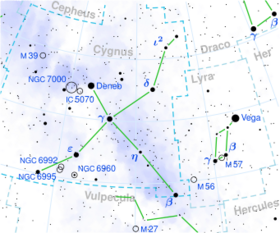Astronomy:Rho Cygni
| Observation data Equinox J2000.0]] (ICRS) | |
|---|---|
| Constellation | Cygnus |
| Right ascension | 21h 33m 58.85298s[1] |
| Declination | 45° 35′ 30.6179″[1] |
| Apparent magnitude (V) | 4.02 [2] |
| Characteristics | |
| Spectral type | G8 III Fe-0.5[3] |
| U−B color index | +0.56[2] |
| B−V color index | +0.89[2] |
| Astrometry | |
| Radial velocity (Rv) | +6.88[4] km/s |
| Proper motion (μ) | RA: −23.79[1] mas/yr Dec.: −93.70[1] mas/yr |
| Parallax (π) | 26.39 ± 0.15[1] mas |
| Distance | 123.6 ± 0.7 ly (37.9 ± 0.2 pc) |
| Absolute magnitude (MV) | 1.11[5] |
| Details | |
| Mass | 2.16[6] M☉ |
| Radius | 7.81[6] R☉ |
| Luminosity | 37.1[6] L☉ |
| Temperature | 5,100[6] K |
| Metallicity [Fe/H] | −0.05[7] dex |
| Rotational velocity (v sin i) | 0.71[7] km/s |
| Age | 660[7] Myr |
| Other designations | |
| Database references | |
| SIMBAD | data |
Rho Cygni, Latinized from ρ Cygni, is a yellow-hued star in the northern constellation of Cygnus. It is visible to the naked eye with an apparent magnitude of 4.02.[2] The measured annual parallax shift is 26.39 milliarcseconds,[1] which yields a distance estimate of 124 light years. It is moving further from the Sun with a radial velocity of +6.88.[4] The star is a member of the thin disk population of the Milky Way galaxy.[7]
This is an evolved giant star of type G with an estimated age of 660[7] million years and a stellar classification of G8 III Fe-0.5.[3] The suffix notation indicates the spectrum shows a mild underabundance of iron in the outer atmosphere. It has about 2.16 times the mass of the Sun and 7.81 times the Sun's girth.[6] The star is radiating 37 times the Sun's luminosity from its enlarged photosphere at an effective temperature of 5,100 K.[6]
Rho Cygni is a bright X-ray source with a luminosity of 10.26×1029 ergs s−1.[8] It has a maximum magnetic field strength of 7.3±0.5 G[9] at the surface.
References
- ↑ 1.0 1.1 1.2 1.3 1.4 1.5 van Leeuwen, F. (2007). "Validation of the new Hipparcos reduction". Astronomy and Astrophysics 474 (2): 653–664. doi:10.1051/0004-6361:20078357. Bibcode: 2007A&A...474..653V. Vizier catalog entry
- ↑ 2.0 2.1 2.2 2.3 Ducati, J. R. (2002). "VizieR Online Data Catalog: Catalogue of Stellar Photometry in Johnson's 11-color system". CDS/ADC Collection of Electronic Catalogues 2237: 0. Bibcode: 2002yCat.2237....0D.
- ↑ 3.0 3.1 Keenan, Philip C.; McNeil, Raymond C. (1989). "The Perkins catalog of revised MK types for the cooler stars". Astrophysical Journal Supplement Series 71: 245. doi:10.1086/191373. Bibcode: 1989ApJS...71..245K.
- ↑ 4.0 4.1 Soubiran, C. et al. (March 2008), "Vertical distribution of Galactic disk stars. IV. AMR and AVR from clump giants", Astronomy and Astrophysics 480 (1): 91–101, doi:10.1051/0004-6361:20078788, Bibcode: 2008A&A...480...91S
- ↑ Da Silva, Ronaldo et al. (August 2015). "Homogeneous abundance analysis of FGK dwarf, subgiant, and giant stars with and without giant planets". Astronomy and Astrophysics 580A: 24–42. doi:10.1051/0004-6361/201525770. Bibcode: 2015A&A...580A..24D. Vizier catalog entry
- ↑ 6.0 6.1 6.2 6.3 6.4 6.5 Reffert, Sabine et al. (2015). "Precise radial velocities of giant stars. VII. Occurrence rate of giant extrasolar planets as a function of mass and metallicity". Astronomy and Astrophysics 574A (2): 116–129. doi:10.1051/0004-6361/201322360. Bibcode: 2015A&A...574A.116R. Vizier catalog entry
- ↑ 7.0 7.1 7.2 7.3 7.4 Jofré, E. et al. (2015). "Stellar parameters and chemical abundances of 223 evolved stars with and without planets". Astronomy & Astrophysics 574: A50. doi:10.1051/0004-6361/201424474. Bibcode: 2015A&A...574A..50J.
- ↑ Makarov, Valeri V. (October 2003), "The 100 Brightest X-Ray Stars within 50 Parsecs of the Sun", The Astronomical Journal 126 (4): 1996–2008, doi:10.1086/378164, Bibcode: 2003AJ....126.1996M.
- ↑ Aurière, M. et al. (February 2015), "The magnetic fields at the surface of active single G-K giants", Astronomy & Astrophysics 574: 30, doi:10.1051/0004-6361/201424579, A90, Bibcode: 2015A&A...574A..90A.
 |


